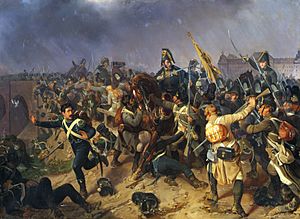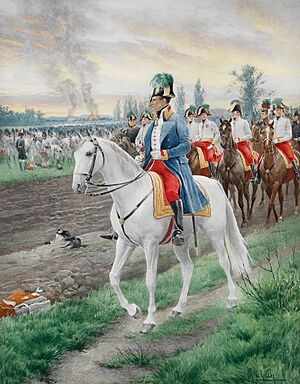Battle of Znaim facts for kids
Quick facts for kids Battle of Znaim |
|||||||
|---|---|---|---|---|---|---|---|
| Part of the War of the Fifth Coalition | |||||||
 Episode from the meeting near Znaim 1809 |
|||||||
|
|||||||
| Belligerents | |||||||
| Commanders and leaders | |||||||
| Archduke Charles of Austria | Auguste de Marmont on the 10th, joined by Napoleon I and André Masséna on the 11th | ||||||
| Strength | |||||||
| 64,000 | 36,660 | ||||||
| Casualties and losses | |||||||
| 5,000–6,000, 2 guns | 3,000 | ||||||
The Battle of Znaim was the final battle between Austria and France during the War of the Fifth Coalition. It took place on July 10-11, 1809, near the town of Znaim (now Znojmo in the Czech Republic).
After losing the Battle of Wagram, Archduke Charles of Austria led his army north. He hoped to gather his tired soldiers and prepare for another fight. The French army, led by Napoleon I, had also suffered losses. They did not chase the Austrians right away.
However, two days later, Napoleon ordered his troops to follow. He wanted to defeat the Austrians for good. The French army finally caught up with the Austrians at Znaim. This happened on July 10, 1809.
The Austrians knew they were not ready for a big battle. They suggested a ceasefire, which is a temporary stop to fighting. Archduke Charles wanted to start peace talks with Napoleon.
But Marshal Auguste de Marmont, a French commander, refused to stop fighting. He sent his XI Corps, about 10,000 men, into battle. Marmont's troops were greatly outnumbered. So, Marshal André Masséna had to join the fight to help him.
By July 11, Masséna's soldiers had joined Marmont's. The Austrians also brought in more troops to defend their positions around Znaim. The fighting lasted for two days. Both sides lost many soldiers, and neither side gained an advantage.
Finally, Napoleon arrived with news of an armistice. An armistice is an agreement to stop fighting. He ordered Marmont to end the battle. The Battle of Znaim was the last major fight between Austria and France in this war.
Why the Battle Started
The Battle of Znaim happened because Archduke Charles made a decision. He wanted his army to perform a "rearguard action." This means a small part of his army would fight to protect the main army. This would give the main army time to safely move its supplies and equipment away. They were heading towards Moravia.
Marmont’s French and Bavarian soldiers were the first of Napoleon’s troops to arrive. They followed the Thaya river. Marmont thought he was only facing a small rearguard. So, he ordered his Bavarian troops to attack the village of Tesswitz. This village was south of Znaim. The rest of his troops attacked the village of Zuckerhandl.
The Battle Unfolds
The Bavarian soldiers successfully captured Tesswitz. But then, Austrian reinforcements arrived and pushed them out. Marmont ordered another attack, and Tesswitz was taken again. However, it was lost soon after. The village changed hands many times that day. This was the toughest fighting the Bavarians saw in the entire war.
Marmont had hoped to send his cavalry (soldiers on horseback) around the back of the Austrian rearguard. But when they reached high ground above Tesswitz, they saw five enemy army groups. The French cavalry had to retreat. They faced a large group of Austrian cuirassiers (heavily armored cavalry).
Marmont was now fighting against 40,000 Austrian soldiers. He was greatly outnumbered. Still, his men managed to hold onto both Tesswitz and Zuckerhandl through the night. Archduke Charles moved his forces into a strong defensive spot. This position allowed them to control the north bank of the Thaya river and the town of Znaim.
Napoleon arrived at Tesswitz at 10:00 A.M. He had brought more cavalry and artillery (cannons). But he still believed his army was too small for a full attack. His plan was to use Masséna’s corps to keep the Austrians busy all day. He would wait for the armies of marshals Louis-Nicolas Davout and Nicolas Oudinot. They were expected to arrive early on July 12.
Masséna launched his attack on the far right side of the Austrian position. This was during the middle of the morning. His troops quickly captured the main bridge across the Thaya river, south of Znaim. His soldiers then took two small villages. After that, they advanced directly towards Znaim. Meanwhile, Charles sent two grenadier brigades (elite soldiers) to reinforce the Austrian position. These grenadiers attacked during a thunderstorm. They initially pushed the French soldiers back.
After the Fighting
Around 7:00 P.M., French and Austrian officers rode along the battle lines. They announced a cease-fire. This led to an armistice being signed on July 12, 1809. The Battle of Znaim was the last major action of the War of the Fifth Coalition.
The two sides later signed a peace treaty. This happened at the Schönbrunn Palace on October 14, 1809.


